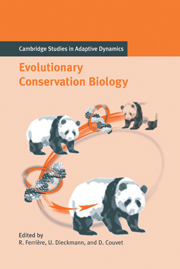Book contents
- Frontmatter
- Contents
- Contributing Authors
- Acknowledgments
- Notational Standards
- 1 Introduction
- Part A Theory of Extinction
- Part B The Pace of Adaptive Responses to Environmental Change
- Part C Genetic and Ecological Bases of Adaptive Responses
- Part D Spatial Structure
- 12 Genetic Structure in Heterogeneous Environments
- 13 Conservation Implications of Niche Conservatism and Evolution in Heterogeneous Environments
- 14 Adaptive Responses to Landscape Disturbances: Theory
- 15 Adaptive Responses to Landscape Disturbances: Empirical Evidence
- Part E Community Structure
- References
- Index
- The International Institute for Applied Systems Analysis
12 - Genetic Structure in Heterogeneous Environments
Published online by Cambridge University Press: 15 August 2009
- Frontmatter
- Contents
- Contributing Authors
- Acknowledgments
- Notational Standards
- 1 Introduction
- Part A Theory of Extinction
- Part B The Pace of Adaptive Responses to Environmental Change
- Part C Genetic and Ecological Bases of Adaptive Responses
- Part D Spatial Structure
- 12 Genetic Structure in Heterogeneous Environments
- 13 Conservation Implications of Niche Conservatism and Evolution in Heterogeneous Environments
- 14 Adaptive Responses to Landscape Disturbances: Theory
- 15 Adaptive Responses to Landscape Disturbances: Empirical Evidence
- Part E Community Structure
- References
- Index
- The International Institute for Applied Systems Analysis
Summary
Introduction
Human activities dominate many of the world ecosystems and have resulted in the fragmentation of numerous habitat types and the animal and plant populations that inhabit them. As natural areas become smaller and more fragmented, it is increasingly important to understand the ecological and evolutionary dynamics of fragmented populations.
The amount of genetic variation maintained by a population influences the probability of its long-term survival, because genetic variation is a prerequisite for evolutionary adaptation to a changing environment (Lande and Barrowclough 1987). Thus, measurement of genetic variation should be a fundamental part of long-term population management programs. Box 12.1 discusses some of the types of genetic variation relevant to evolutionary processes and presents different measures used to monitor the level of genetic variability in natural populations.
The amount of genetic variability maintained by a population is determined primarily by the joint actions of mutation, selection, and genetic drift. The strength of genetic drift is not determined by the census size of the population, N, but by its effective size Ne (see Box 12.2). The effective population size Ne can be an order of magnitude smaller than the number of adults in the population for a host of different reasons. The best known are uneven sex ratios, temporal fluctuations in population size, variance in reproductive success among individuals, and nonrandom mating. However, as we show later, metapopulation dynamics can be considered one of the most important factors to determine Ne.
- Type
- Chapter
- Information
- Evolutionary Conservation Biology , pp. 229 - 243Publisher: Cambridge University PressPrint publication year: 2004
- 5
- Cited by

